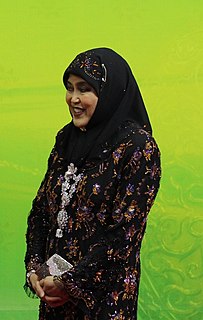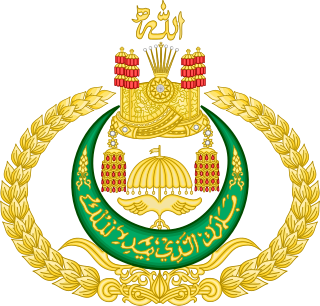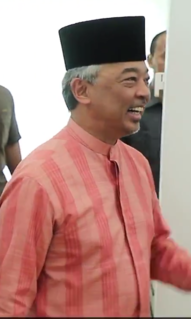The Malay language has a complex system of styles, titles and honorifics, which are used extensively in Brunei and Malaysia.
Permaisuri Siti Aishah was the consort of the 11th Yang di-Pertuan Agong of Malaysia, Sultan Salahuddin Abdul Aziz Shah. She is the youngest ever Raja Permaisuri Agong (Queen) of Malaysia, ascending the throne at the age of 28 on 26 April 1999. During her reign as Raja Permaisuri Agong, she was known as Tuanku Siti Aishah.
Tengku Ampuan Hajah Jemaah binti Almarhum Raja Ahmad was the second Raja Permaisuri Agong of Malaysia during the brief reign of her husband, Sultan Hisamuddin Alam Shah Al-Haj ibni Almarhum Sultan Alaeddin Sulaiman Shah. She was also Tengku Ampuan of Selangor during her husband's reign as Sultan of Selangor.
Raja Permaisuri Bainun is the former Raja Permaisuri of Perak the (Queen) Malaysian state of Perak. She was also the ninth Raja Permaisuri Agong (Queen) of Malaysia, the first commoner to be installed as Queen. She is the widow of Sultan Azlan Shah and the mother of the incumbent Sultan Nazrin Shah. She is now styled as Yang Maha Mulia Raja Permaisuri Tuanku Bainun.

Mohamed Bolkiah is a member of the royal family of Brunei. He is the second son of Omar Ali Saifuddien III, the 28th Sultan of Brunei, and Raja Isteri (Queen) Pengiran Anak Damit. He is the Head of the Brunei’s Viziers. After Brunei’s independence in 1984, he became the country’s first foreign minister, serving from 1984 until 22 October 2015. He served in the cabinet as the Minister of the Brunei's Ministry of Foreign Affairs and Trade alongside the second Minister of Foreign Affairs and Trade, Lim Jock Seng.

Crown Prince Haji Al-Muhtadee Billah is the eldest son of Sultan Hassanal Bolkiah and his wife Princess Saleha binti Mohammad Alam. He is the Crown Prince of Brunei Darussalam and is first in the line of succession to the Bruneian throne.

In the English language, an English honorific is a form of address indicating respect. These can be titles prefixing a person's name, e.g.: Mr, Mrs, Miss, Ms, Mx,Sir, Dr, Lady or Lord, or titles or positions that can appear as a form of address without the person's name, as in Mr President, General, Captain, Father, Doctor or Earl.
Majesty is an English word derived ultimately from the Latin maiestas, meaning greatness, and used as a style by many monarchs, usually Kings or Queens where used, the style outranks the style of (Imperial/Royal) Highness, but is inferior to the style of Imperial Majesty. It has cognates in many other languages, especially Indo-European languages of Europe.

Duli Yang Maha Mulia (DYMM) is the title of the state anthem of Selangor, Malaysia, adopted in 1967. The lyricist is unknown but the music was written by Saiful Bahri.
Highness is a formal style used to address or refer to certain members of a reigning or formerly reigning dynasty. It is typically used with a possessive adjective: "His Highness", "Her Highness" (HH), "Their Highnesses", etc. Although often combined with other adjectives of honour indicating rank, such as "Imperial", "Royal" or "Serene", it may be used alone.

Saleha is the Queen consort of Brunei as the wife of Sultan Hassanal Bolkiah, the current Sultan of Brunei. She was the daughter of Pengiran Pemancha Pengiran Anak Haji Mohammad Alam and Pengiran Anak Hajah Besar. After her husband was crowned as the Sultan and Yang Di-Pertuan of Brunei, she succeeded her mother-in-law, Pengiran Anak Damit, as Raja Isteri. She is the mother of Crown Prince Al-Muhtadee Billah.

Pengiran Muda Abdul Muntaqim ibni Al-Muhtadee Billah is the oldest child and first son of Al-Muhtadee Billah, heir to the Sultan of Brunei, and his wife, Sarah, Crown Princess of Brunei. He has a younger sister, Princess Muneerah Madhul, who was born in 2011. The Prince is second-in-line to become Sultan of Brunei after his father Al-Muhtadee Billah. His father is heir to Abdul Muntaqim's grandfather Sultan Haji Hassanal Bolkiah of Brunei.

Prince Haji 'Abdul 'Azim of Brunei is the second born prince of Hassanal Bolkiah, Sultan of Brunei and fourth in line to succeed the throne of Brunei.

Al-Sultan Abdullah Ri'ayatuddin Al-Mustafa Billah Shah ibni Almarhum Sultan Haji Ahmad Shah Al-Musta'in Billah is the 16th Yang di-Pertuan Agong of Malaysia and the sixth Sultan of Pahang. He was proclaimed as Sultan on 15 January 2019, succeeding his father, Sultan Ahmad Shah, whose abdication was decided at a Royal Council meeting on 11 January.

The House of Bolkiah is the ruling royal family of Brunei Darussalam. It is composed of the descendants of the 1st sultan Sultan Muhammad Shah and his family. The Sultan of Brunei is the head of state and absolute monarch of Brunei. He is also head of government in his capacity as Prime Minister.
'Abdul Mateen is the tenth child and fourth son of Sultan Hassanal Bolkiah of Brunei by his former second wife, Puan Mariam binti Abdul Aziz, who is half Bruneian, a quarter Japanese and a quarter English.

Sultan Nazrin Muizzuddin Shah ibni Almarhum Sultan Azlan Muhibbuddin Shah Al-Maghfur-Lah is the 35th Sultan of Perak. He became the Deputy Yang di-Pertuan Agong of Malaysia, elected on 14 October 2016, before Sultan Muhammad V abdicated on 6 January 2019. He is currently the Deputy Yang di-Pertuan Agong.

Abdul Malik, is a prince of Brunei. He is the third son of Sultan Hassanal Bolkiah by his first wife, Queen Saleha.
Tunku Hajah Azizah Aminah Maimunah Iskandariah binti Almarhum Al-Mutawakkil Alallah Sultan Iskandar Al-Haj is the Raja Permaisuri Agong of Malaysia and the Tengku Ampuan of Pahang.

Pengiran Muda Muhammad Aiman ibni Al-Muhtadee Billah is the second son and third child of Al-Muhtadee Billah, heir to the Sultan of Brunei, and his wife, Sarah, Crown Princess of Brunei.










